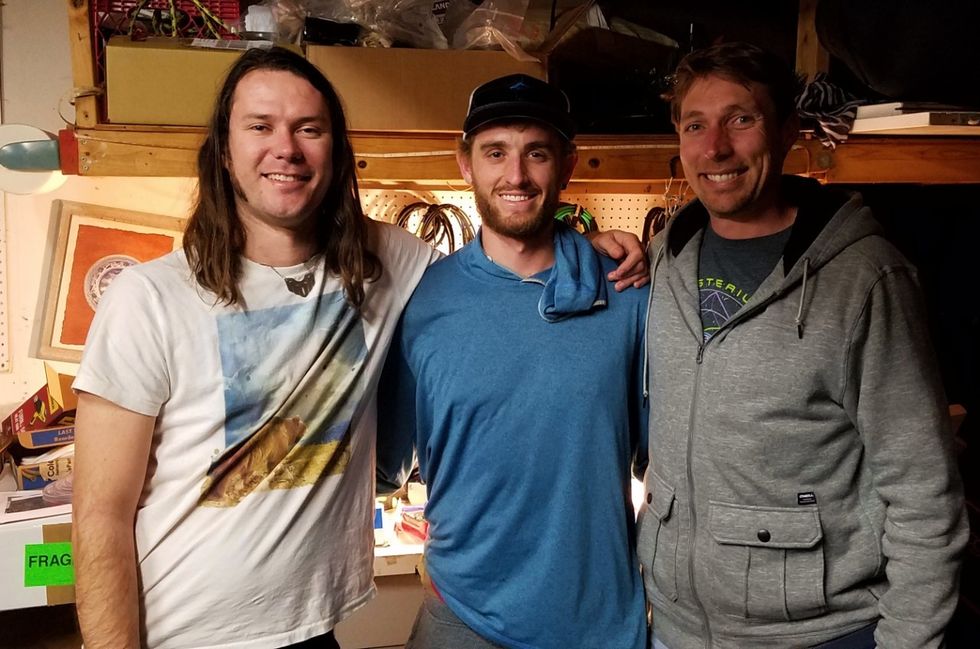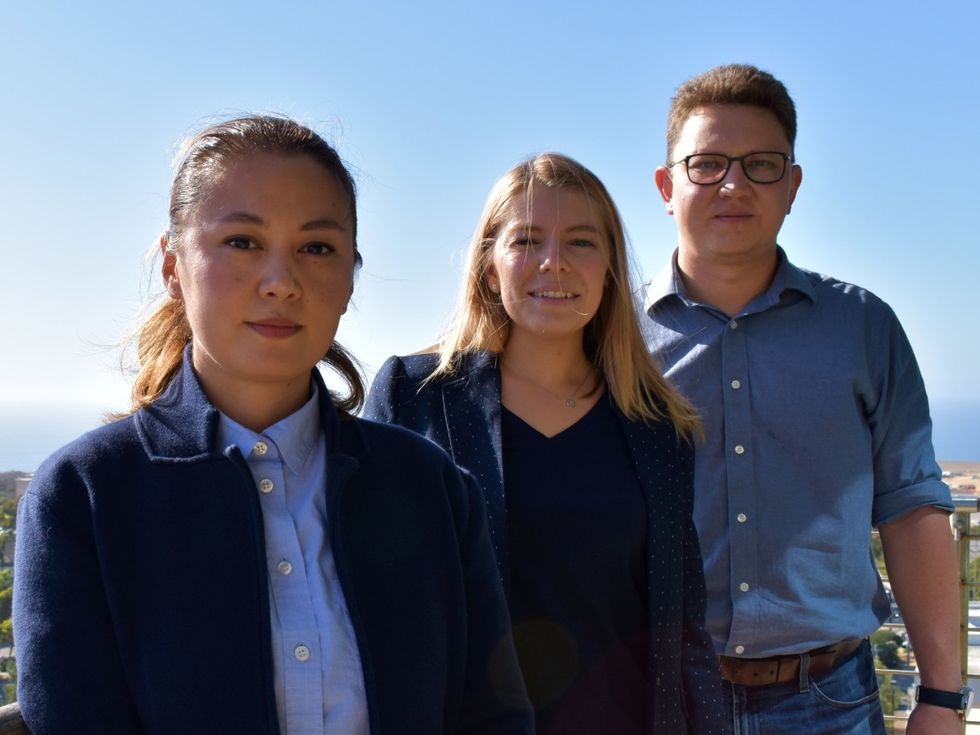

Get in the KNOW
on LA Startups & Tech
X
Image by Black Salmon/ Shutterstock
PowerPlant Partners Closes Third Fund at $330M
Kristin Snyder
Kristin Snyder is dot.LA's 2022/23 Editorial Fellow. She previously interned with Tiger Oak Media and led the arts section for UCLA's Daily Bruin.
PowerPlant Partners, a Los Angeles and San Francisco-based investment management firm, closed a $330 million fund.
With the final closing of PowerPlant Ventures III L.P. (PPV Fund III), the firm plans to expand its current focus on plant-based consumer food and beverage brands to incorporate consumer technology alongside service and enablement companies. Dan Gluck, PowerPlant co-managing partner, told dot.LA the firm still intends to back companies that center around human and planetary wellness.
“What we've announced is that as we grow as a firm, plant-based will always 100% be part of our DNA and be part of what we do,” Gluck said. “However, as we grow as a firm, we're seeing a lot more opportunities to broaden our scope of investments to focus on all businesses, consumer-facing as well as even backward in the supply chain, that are sustainable businesses that are furthering people and planetary health.”
As active investors, PPV Fund III plans to invest between $15 million and $40 million in each company. So far, it has invested in four. PowerPlant invested $40 million in a Series C round for Miyoko’s Creamery, which focuses on plant-based cheeses and butter. The other companies focus on beverages—Gluck said Santa Monica-based canned water company Liquid Death appeals to people who want the appearance of drinking an energy drink without the added sugar.
With their “death to plastic” and trendy aluminum cans which have made waves across social media platforms, Gluck said Liquid Death follows PowerPlant’s intent to better the planet. Additionally, he said Calgary-based Partake Brewing is rising in the non-alcoholic beer field as younger generations shift to healthier habits.
For its final investment, PowerPlant hand-crafted SYSTM Foods by acquiring and combining coffee company Chameleon Cold-Brew and beverage brand REBBL. PowerPlant was able to buy both companies at a discount, giving them the chance to create meaningful value, he said.
“There's a lot of companies out there,” he said. “We believe that there's a lot of synergies to be had by combining several brands. And, furthermore, part of that thesis was that there was going to be a period of market volatility where there was going to be a shakeout in the environment in the market where we would be able to acquire brands that are cheap.”
PowerPlant’s portfolio includes El Segundo-based Beyond Meat, a plant-based meat substitute producer, and Los Angeles-based Thrive Market, an organic food e-commerce retailer.
As PowerPlant plans to move into the consumer wellness space, the firm is moving away from investing in early-stage consumer businesses to funding growth-stage companies. All four PPV Fund III companies are growing quickly, he said, and the partners’ experience in scaling and exiting businesses can provide expertise for growing companies.
“What we know is that early stage consumer investing—it's tough, frankly, and we think there's just simply not enough moats for traditional consumer brands other than the brand itself,” he said. “We have really decided that the opportunity set from a financial perspective makes the most sense to be a bit more focused on growth.”
From Your Site Articles
- This Week in 'Raises': Battle Motors Grabs $150M, PowerPlant ... ›
- How Science Inc CEO Mike Jones Stays Ahead of the Trends - dot.LA ›
- Liquid Death Mountain Water Drops a Death Metal Album - dot.LA ›
- Liquid Death Raises $23 Million in Series B Funding - dot.LA ›
Related Articles Around the Web
Kristin Snyder
Kristin Snyder is dot.LA's 2022/23 Editorial Fellow. She previously interned with Tiger Oak Media and led the arts section for UCLA's Daily Bruin.
https://twitter.com/ksnyder_db
An Early Peek at First Look's Showcase of Cutting-Edge Science Startups
07:10 AM | September 15, 2020
Photo by Ameen Fahmy on Unsplash
Eliminating battery waste, developing new hair growth therapy, fixing carbon dioxide. These are among some of the ambitious problems that companies are trying to solve at the First Look SoCal Innovation Showcase beginning Tuesday.
Hosted by nonprofit Alliance for SoCal Innovation, the online event connects early-stage tech and life science companies with investors and serial entrepreneurs.
Founders of the 30 companies selected to participate come from universities and academic institutions across the region. Tech developed by these researchers and scientists is just emerging from labs, said Steven Gilison from the Alliance. This means most take longer to fundraise than typical startups and this opportunity often represents the start of their funding journey.
It's the third year the Alliance will host the showcase, which has been running for over 10 years. The event starts Tuesday with a daylong focus on life science founders and ends with the next day centered on tech. Each day begins with a keynote presentation and ends with a VC investor panel — a feature that last year brought in funding for several startups.
Here's a snapshot of the founders gearing up to pitch:
BioZen Batteries Aims to Solve Our Energy Storage Issues

Left to right: BioZen Batteries' co-founders Zach Rengert, Nate Kirchhofer and Eric Brigham.
Nate Kirchhofer, co-founder and CEO of BioZen Batteries, wants to make batteries that will outlive him.
Santa Barbara-based BioZen creates organic electrolytes, the active material inside a specific type of battery called a "redox flow battery." It's a different type of technology that differs from the lithium batteries often used in mobile applications like cars and phones. Only 5% of those get recycled.
BioZen's batteries are well suited for green, large-scale energy storage, Kirchhofer said. For example, batteries that help solar panels connect to the grid or provide backup during disasters when the power goes out.
Kirchhofer, an electrochemist, founded the company in June of 2019 with Zach Rengert, a materials chemist, and Eric Brigham, the company's CFO. Kirchhofer and Rengert met while getting their doctorate at UC Santa Barbara.
There hasn't yet been a push for sustainable batteries because it isn't economically incentivized, Kirchhofer told dot.LA. He said that his batteries are cheaper than competitors.
Kirchhofer's product fits into a growing renewable energy market and a social movement in which individuals want to do their part. He's worked for four startups but says this one is poised to make the biggest impact.
"If it's not our generation that solves climate change, there's not another chance. There's not another Earth." he said. "If we can make these batteries happen, we can truly integrate renewable energy and stop the petroleum-dominated energy paradigm we're part of."

Amplifica's founder Dr. Maksim Plikus
Amplifica Treats Baldness with Mole Molecules
Back in 2013, Amplifica's founder Dr. Maksim Plikus began studying hairy moles. Though some find the growths unsightly, his work showed promise for baldness treatment.
He, along with colleagues at UC Irvine, discovered that molecules from moles that grow excessive hair can induce follicle growth when administered anywhere on the skin.
"As long as you can tease it out and replicate it in the form of purified molecules, you can achieve essentially what we think would be a novel, revolutionary solution to baldness," Plikus told dot.LA.
Plikus said his company is the first to solve hair loss by replicating cells from hairy moles to stimulate hair growth. At the moment, hair follicle research has emerged as a leading experimental model for studying stem cells.
By 2025, hair-loss products are projected to surpass $12 billion, Plikus said. But only two drugs are FDA approved and require daily treatment in the form of pills, which he said come with long-term side effects.
Amplifica says it's poised to put a more effective and convenient solution on the market. Pinkus' proposed product is a topical solution requiring less frequent application, like getting Botox injections a few times per year.
FixingCO2 Aims to Recycle Fuel from the Air

FixingCO2's team. CEO Eldar Akhmetgaliyev is at right.
FixingCO2 got its start on Mars. Like the name says, the company aims to fix the global carbon problem that's fueling climate change.
In 2018, co-founder Alma Zhanaidarova's professor and research group at UC San Diego received a grant from NASA to build out a reactor that makes renewable fuels and chemicals from carbon dioxide, often a byproduct of industrial waste. The technology was being developed in anticipation of a one-day human mission to Mars, where 95% of the atmosphere is carbon dioxide.
Now, the San Diego-based startup is commercializing their product for earthlings.
"It's a different application but the same core technology," co-founder Eldar Akhmetgaliyev told dot.LA. "Instead of making fuels from oil or any other fossil sources, we can make them essentially from air."
The team is developing the hardware to capture industrial emissions blamed for much of the Earth's warming. The product has significant application for the aviation industry, where planes are built to burn jet fuel that produces carbon emissions.
"These kinds of technologies provide them a pathway to decarbonization," he said. "They can use fuels made from CO2 so they're not contributing to climate change."
As fires burn through California and the Pacific Northwest, Akhmetgaliyev said there's urgency for innovators in the carbon tech market. "We're pretty much turning our planet into Mars," he said.
He said that by 2050, about 14% of overall carbon reduction will come from carbon capture and utilization (CCUS) technology like his.
"The market hasn't met its opportunity and with the effects of climate change being seen everyday, there's going to be more drive towards these low carbon technologies."
From Your Site Articles
- Can LA County's New Fund Get Local Biotech Startups to Stick ... ›
- Where Is the Investment in New Music Technology Going? - dot.LA ›
- Cutting Edge Science Startups to Watch - dot.LA ›
- The Early-Stage Startups in LA Set to Take Off in 2021 - dot.LA ›
- First Look Features Life Science Startups from SoCal Schools - dot.LA ›
- CarbonCapture Raises $35 Million to Tackle Climate Change - dot.LA ›
- First Look SoCal Innovation Showcase 2022: 3 Things to Watch - dot.LA ›
- Southern California Grows Roots as Potential Hotspot For Hair Loss Therapies - dot.LA ›
- Largest Battery Project in California Goes Online - dot.LA ›
- Largest Battery Project in California Goes Online - dot.LA ›
- LA Tech Raises: Griffin Capital Raises $4.9M Third Round - dot.LA ›
Related Articles Around the Web
Read moreShow less
Francesca Billington
Francesca Billington is a freelance reporter. Prior to that, she was a general assignment reporter for dot.LA and has also reported for KCRW, the Santa Monica Daily Press and local publications in New Jersey. She graduated from Princeton in 2019 with a degree in anthropology.
https://twitter.com/frosebillington
francesca@dot.la
Cap Tables to Costumes: Whatnot’s Mega Round and Your LA Weekend Plan 🎃
10:39 AM | October 31, 2025
🔦 Spotlight
Happy Friday Los Angeles!
Live shopping’s LA moment
Whatnot, the LA born marketplace for live auctions, raised $225 million at an $11.5 billion valuation. The round was co led by DST Global and CapitalG, with Sequoia, Alkeon, a16z, Greycroft, BOND, and others participating. The company says the money goes to international expansion, trust and safety, and seller tools - fuel for a category that has moved from “Is this a fad?” to “How big does this get in the West?”
Why it matters
If that valuation sounds sudden, you’re not imagining it. Whatnot’s last raise in January valued the company around $5 billion. Less than 10 months later, the number has more than doubled, tracking a year of surging GMV and a social commerce flywheel spinning across TikTok Shop, YouTube, and Amazon. For LA, it’s a marquee bet on the creator commerce stack we do best: community, content, and culture that converts
The bigger picture
The implications go well beyond trading cards. Live, personality led storefronts are evolving from hobby to underwritable small business. If Whatnot uses this cash to keep fraud low and throughput high, we could see an LA export take root globally, not just as an app category but as a job category. That is a storyline to watch into Q4 and beyond.
From cap tables to costumes: Halloween in LA 🎃
You’ve earned some offline fun. Heading into Halloween weekend (Oct. 31–Nov. 2), LAist’s guide has a little of everything: neighborhood Día de los Muertos celebrations (from the Canoga Park family festival to an ofrenda for pets at Annenberg PetSpace in Playa Vista), the Frogtown Arts weekend along the LA River, plus plenty of screenings and concerts across town. Bookmark the list, pick your neighborhood, and maybe swap “add to cart” for “add to calendar.”
Send tips, sightings, and spooky term sheets our way. Venture deals for LA companies, funds, and acquisitions are below.
🤝 Venture Deals
LA Companies
- Bryan Johnson’s longevity startup Blueprint raised $60M from a celebrity heavy group of backers including Kim Kardashian, Naval Ravikant, Alex Hormozi, Ari Emanuel, and the Winklevoss twins to turn Johnson’s personal Blueprint regimen into a broader consumer platform. The company says the funding will help package diagnostics, biomarker tracking, prescriptions, nutrition, and other longevity services into an accessible offering. The round underscores mainstream interest in data driven wellness despite past questions about Blueprint’s trajectory. - learn more
- Rarity PBC raised $4.6M in seed financing to advance a one-time, autologous blood-stem-cell gene therapy for ADA-SCID (“bubble baby” disease) that it has licensed from UCLA researcher Dr. Donald Kohn. The round, led by biotech investor Steve Oliveira (Nemean Asset Management), will support manufacturing and steps toward commercial readiness. - learn more
- Fruitist raised $150M led by a vehicle managed by J.P. Morgan Asset Management, with participation from Aliment Capital and Ray Dalio’s family office. The LA-based superfruit brand says the funding will fuel crop expansion, cold storage, and automation as it scales distribution to 12,500+ stores and targets continued growth following roughly $400M in trailing sales. - learn more
- Homecourt, the Los Angeles based luxury home and personal fragrance brand founded by Courteney Cox, raised an $8M Series A led by CULT Capital. The company says the funding will fuel brand marketing, team hires, and infrastructure as it expands beyond DTC into 300+ retail doors including Nordstrom, Bluemercury, and Revolve. Homecourt has broadened from home care into body and laundry collections since launching in 2022. - learn more
LA Venture Funds
- Aliavia Ventures participated in Human Health’s $8.5M raise, joining LocalGlobe, Airtree, Skip Capital and Scale Investors to back the precision health platform from former Canva product leaders Georgia Vidler and Kate Lambridis. The funding will support international expansion, deepen product intelligence in areas like women’s health, respiratory and pain, and scale Human Evidence for patient driven research; Human Health reports more than 200,000 users and 20 million logged health actions to date. - learn more
- Riot Ventures participated in EnduroSat’s $104M funding round, alongside Google Ventures, Lux Capital, the European Innovation Council Fund, and Shrug Capital. The Sofia based satellite manufacturer says the capital will scale production of its ESPA class (200 to 500 kg) modular satellite buses, targeting capacity of up to two satellites per day at a new 188,340 square foot Space Center so constellation customers can get to orbit faster. The raise is EnduroSat’s second this year and follows a €43 million round in May. - learn more
- Rocana Venture Partners participated in Recess’s $30M Series B, which was led by CAVU Consumer Partners and included Midnight Ventures, Torch Capital, Doehler Ventures, KAS Venture Partners, Vanquish, and Craig Kallman. The relaxation-beverage company will use the capital to grow its team, expand retail distribution, and ramp marketing, and it also named former Nutrabolt executive Kyle Thomas as President and Co-CEO to help scale the brand. Recess says it now sells in more than 15,000 U.S. stores, positioning it to capitalize on demand for functional relaxation and alcohol-alternative drinks. - learn more
- Terasaki Institute participated in iOrganBio’s $2M launch financing, joining First Star Ventures (lead), IndieBio, Cape Fear BioCapital, 2ndF, and Alix Ventures. The Chapel Hill based startup unveiled CellForge, an AI powered cell-manufacturing platform that pairs predictive models with high throughput control to engineer reproducible human cells and organoids for drug discovery and cell therapies. The funds support product development and early deployments. - learn more
- Fox Sports made a strategic investment in Shadow Lion, the creative agency and IP studio co-founded by Tom Brady, forming a partnership to develop talent-led originals, digital content, long-form projects, and marquee live events. The deal includes a new Los Angeles hub for Shadow Lion on the Fox lot, with early tentpoles including a University of Michigan football docuseries from executive producers Brady and Jim Harbaugh and collaboration on the Fanatics Flag Football Classic. - learn more
- EB Medical Research Foundation participated in Eliksa Therapeutics’ funding to advance ELK-003, a biological eye drop for ocular complications in epidermolysis bullosa. The round, led by DEBRA Research with support from Cure EB, the Abe Fund, and EB Research Partnership, backs an ongoing pilot study with 18 patients enrolled and no drug-related side effects reported among the first eight who completed treatment. - learn more
- Patron and HartBeat Ventures participated in Sweatpals’ $12M seed round alongside a16z speedrun, backing the community fitness platform as it expands its “daylife” model of IRL wellness events. The funding will support product and market expansion for hosts and gyms using Sweatpals for discovery, ticketing, memberships, and marketing. Business Insider reports the startup now reaches over 1 million monthly users and is growing into new U.S. cities. - learn more
- UP.Partners participated in Lula Commerce’s $8M Series A, led by SEMCAP AI with Rich Products Ventures, GO PA Fund, NZVC, Green Circle Foodtech Ventures, and Outlander VC also joining. The Philadelphia company, active with more than 2,000 retailers, offers an AI powered digital commerce suite for convenience stores covering order ahead, pickup, delivery, and back office tools, and says the round brings total funding to over $16M to meet rising demand. - learn more
- Navitas Capital led WorkHero’s $5M seed to scale its AI powered back office platform for small HVAC contractors, with Workshop Ventures, York IE, and strategic angels also participating. WorkHero combines agentic AI with human account managers to handle invoicing, permits, rebates, warranty registrations, and pricebooks so owners spend less time on admin. The funding will expand engineering and product and add new services such as call answering and bookkeeping. - learn more
LA Exits
- DMI was acquired by Stingray, adding about 8,500 U.S. retail locations to Stingray’s in-store audio advertising network and bringing its total footprint to roughly 33,500 sites. The deal cements Stingray’s leadership in pharmacy retail audio across the two largest chains and brings DMI’s creative services, including cinema advertising and brand marketing, under its umbrella, with CEO Tena Clark staying on to help integrate and expand the offering. - learn more
Read moreShow less
RELATEDTRENDING
LA TECH JOBS


